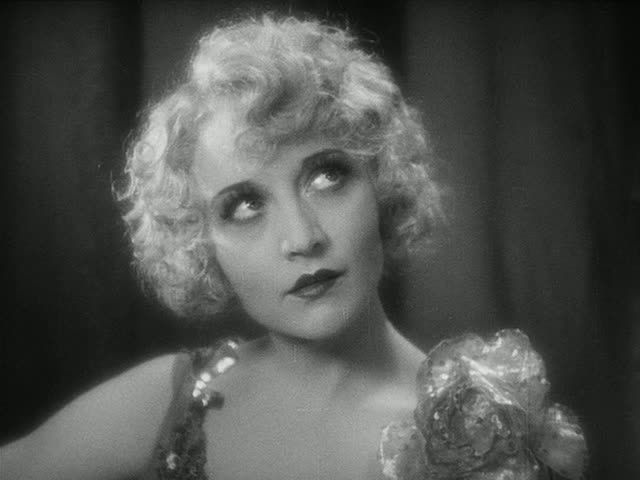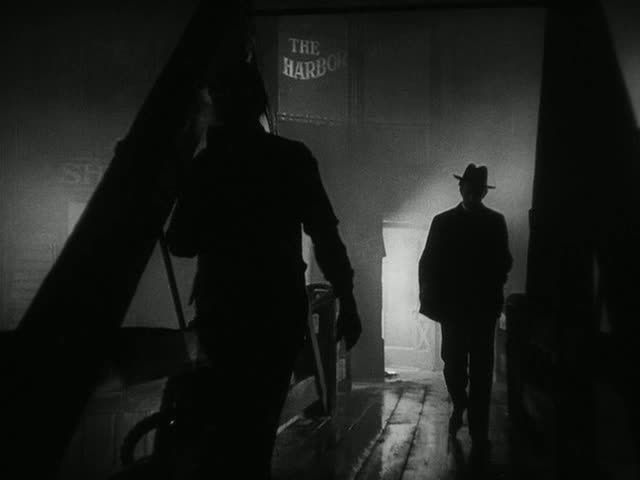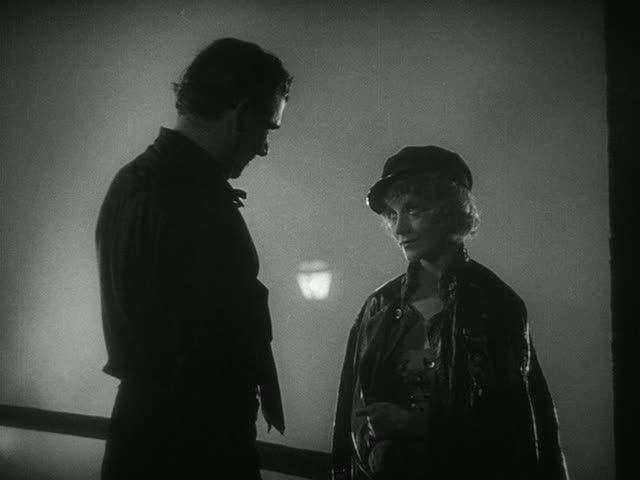

Moody, rowdy, and sensuous, Josef von Sternberg's The Docks of New York is a beautiful work of romantic expressionist cinema. Set on the docks on a one-night shore leave, the film is drenched in atmosphere. The bulk of the film takes place in a wharf tavern, crowded to the rafters with drunken revelers: sailors and stokers on leave, hard-partying women and prostitutes, drunks and tramps. Around the bar, the docks themselves are limited to a few minimalist planks of wood and a whole lot of fog, a thick soup hanging over the wharf, the water a dense black shimmering just below. It's a constrained and claustrophobic film, confined to these few minimally defined areas, essentially a rough sketch that evokes a mood. It's a place populated with rough men and easy women, all of them drifting rather aimlessly through life, desperate to grasp a few moments of pleasure before the next ship sails, before morning comes and they inevitably forget everything that happened the night before.
Bill (George Bancroft) is a stoker, and the film opens in a ship's hold, where Bill and the other men are streaked in grease and ash, their faces smeared with black, sweating and laboring hard in the heat. Bill's a hard, crude man, pushing around the wharf bar, always looking for a fight, pouring barrels of alcohol down his throat. He's somehow, subtly, changed when he rescues a desperate, lonely woman named Mae (Betty Compson) from the harbor after she's jumped in, trying to kill herself. Bill carries her to safety, a dark silhouette in the fog with her limp body in his arms, and when she wakes up, they develop a hesitant, charmingly unsentimental mutual attraction as these two hard-edged people trade sly banter. Over the course of a riotous night at the bar, Bill impetuously proposes to Mae, and they're married in an informal ceremony with the bar patrons cheering and shouting throughout — one of the remarkable things about von Sternberg's bar scenes is that his mise en scène is so perfect that it's easy to forget that there's no sound, that one can't actually hear the clamor that's so vividly conveyed through the silent images. There are few silent films that seem so noisy.
Von Sternberg parallels the developing relationship between Bill and Mae with the marriage of Bill's shipmate Andy (Mitchell Lewis) and his wife (Olga Baclanova). Andy's a man very much like Bill; his mannerisms are the same, he has the same crude, violent way of moving about a room by pushing everyone bodily out of his way. He's married but obviously doesn't see his wife very much. When he runs into her by chance in the bar at the beginning of the film, she's dancing with and passionately kissing another man. This unhappy couple looks at one another with nothing but resentment and contempt, their hatred of one another simmering behind every glance. They're obviously one vision of a possible future for Bill and Mae, a future that's very easy to imagine because the two couples mirror each other so perfectly: the actors are even the same types, with Bill a slightly younger echo of Andy and Mae a younger, less worn-out echo of Andy's wife.


It's thus no surprise when Bill wakes up the next morning and barely remembers his wedding or his grand promises from the night before; in one chilling shot, he throws a bill down on the dresser after getting out of bed, thinks about it a moment, and drops another bill, as though he's decided that his wife at least deserves a little extra payment for his night of pleasure. It takes a long time for Bill to realize that this night wasn't so transitory after all, as this solidly unsentimental man keeps getting drawn back into Mae's orbit, for the first time finding it difficult to leave shore. For such a gritty, rowdy movie, there's a real vein of romanticism here, much of it expressed through von Sternberg's gorgeously moody dockside imagery. Bill and Mae's wedding night is capped off with a phenomenal scene of the newlyweds pausing by a railing, looking out into the fog, with Bill wrapping his coat around his bride and placing his cap on her head at a jaunty angle, as she looks up at him with those big eyes and that wry smile. It's an intoxicating moment, sweet and sad, and it only makes the subsequent scenes of an oblivious Bill waking up the next morning even more heartbreaking.
Mae is such a sweet, sad character in general, and von Sternberg's camera seems to fall in love with her long before Bill belatedly realizes that he'd like to stay with her after all. She looks up at the camera with wide eyes, the whites of her eyes shining, her mouth twisted into a sad smile that conveys the depth of her tragic life experiences. She's wise to the ways of the world, and a part of her never really expects Bill to stick around, but a much more tragic part of her hopes that he will, and it's this that comes out when, as she sews Bill's jacket, a cigarette dangling between her lips, a few crystalline tears drip down her cheeks. Von Sternberg's portrayal of her is boldly sexual and sensual — in one scene, she pulls on her dress, her long bare back to the camera as she stretches her arms up over her head. She's so perfectly comfortable in her own skin, like everyone here: the bar scenes especially are models of languid, casual posing, bodies stretched out and leaning against the railings of the bar. One of the reasons this film feels so casually realistic despite its chiaroscuro stylization is the sublimity of the body language throughout, the way every character's pose, particularly Bill's, seems to suggest imminent violence.
This is a beautiful, bittersweet film with a great deal of poetically expressed emotion in its tender depiction of a sad romance and its foggy images of the docks. Silhouettes fade in and out of the fog, the parties last all night, and in the mornings, when the alcohol has been exhausted and everyone's waking up half-naked and alone, the regrets and the sadness only return, even more overwhelming than before. If occasionally, and maybe temporarily, there's a happy ending, it's only an exception.
This is my favorite von Sternberg, my favorite silent, sometimes I think my favorite movie period. I get lost in it like pretty much nothing else out there. Betty Compson's performance is one of my very favorites ever, so weary and vulnerable and expressive in the most subtle of ways, it's a real shame her career pretty much floundered after the silent period. And Bancroft is so tremendous here. He doesn't really enjoy a strong reputation these days it seems, but he had a crude, earthy quality that I almost always find refreshing, and all of his work for von Sternberg is tremendous, and this is his greatest performance I think.
ReplyDeleteThe stoker's den has just got to be considered one of the greatest of all Hollywood sets. The precision and care that's put into the lighting and layering of all the smoke and fog and steam is just unbelievable, it all has a gorgeous weight and density to it that I've never seen replicated elsewhere, and not just in the stoker's den but also in the saloon where most of the movie is spent. It comes through nicely on the gorgeous Criterion disc, I can only imagine how it would look in an original nitrate print.
I'm glad you address the ending. It seems that people who even consider the film great often have a problem with how supposedly neatly it's wrapped up, but I've always thought it's a sadder, less hopeful ending than its given credit for; viewing these lives as we have for only one day, the last thing that could be said of them is that there are guarantees in place, not to mention the fact that the cloud of an innocent woman being put in jail hangs over everything.
Sternberg can be a tricky director to discuss, because while his films clearly open themselves up to endless formal analysis, their emotional impact is almost always incredibly dense and complex and hard to convey, but you did a great job with this piece, Ed.
Agreed, Drew, that the emotional complexities of this film are difficult to pin down. It's so bittersweet and so layered, and even if the ending suggests some hope, it's by no means unambiguous, and who's to say what will happen to these characters now?
ReplyDeleteI like Bancroft, too, his crudeness is actually very appealing, he's rough and broad and just a lot of fun to watch. A more subtle performance wouldn't be appropriate here or for Bull Weed in Underworld.
And yes, the foggy atmosphere is sublime, definitely some of the best photography of that kind of murky fog.
Yes this is certainly among Von Sternberg's greatest films, (I think I will agree with Drew, that it is his greatest) and just recently received a beautiful transfer to Criterion DVD, along with two other gems from the director, UNDERWORLD and THE LAST COMMAND. Harold Rosson's photography, Helen Lewis' editing and Von Sternberg's staging combine to create one of the most exquisite of films, and one you rightly transcribe at the start of this brilliant essay as 'a beautiful work of romantic expressionist cinema.' And I love that assertion that it's "drenched in atmosphere." In fact all your other descriptive phrases like "constrained and claustrophobic," "an evocation of a mood,"a thick soup of fog hanging over the wharf" bring this film into indellible focus. Yes, it's bittersweet and it's poetic and there's a feeling of Vigo hanging over it, though of course Von Sternberg came first. Gee, I'd like to watch it again right now.
ReplyDeleteIt's certainly the best of the von Sternberg films that I've seen, Sam. Good comparison to Vigo, who certainly must have been a fan as well. It also reminds me a lot of Hawks' A Girl in Every Port, from the same year, with Victor McLaglen playing a very similar type as Bancroft.
ReplyDelete